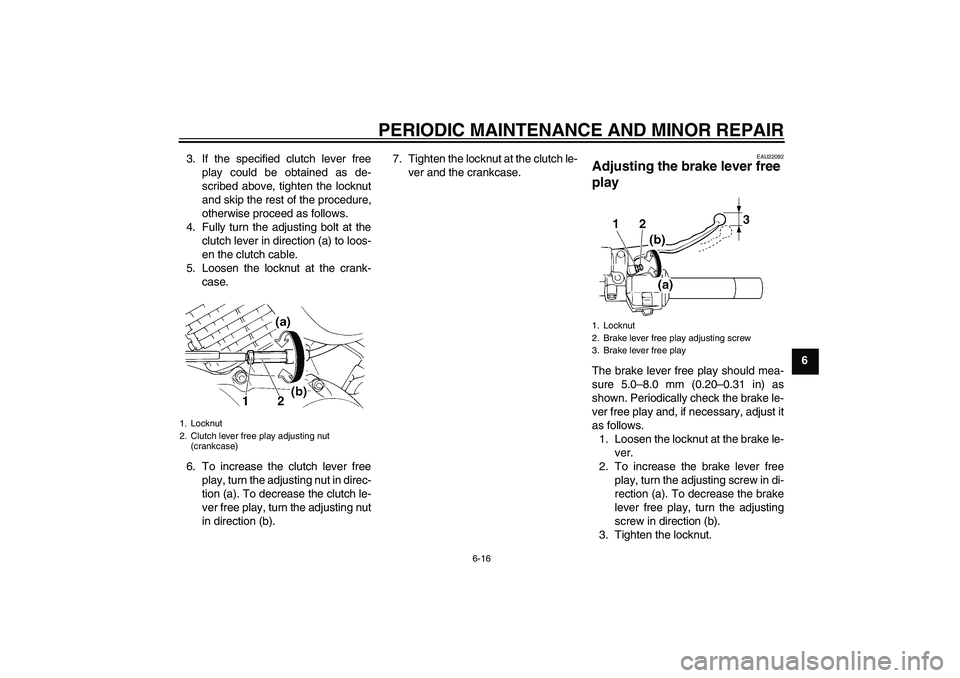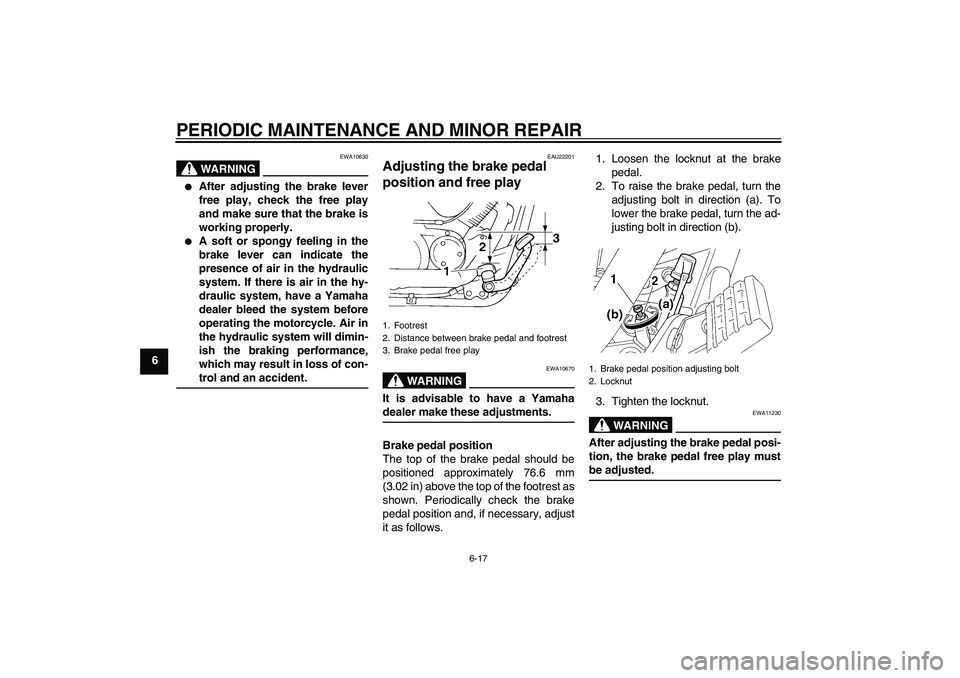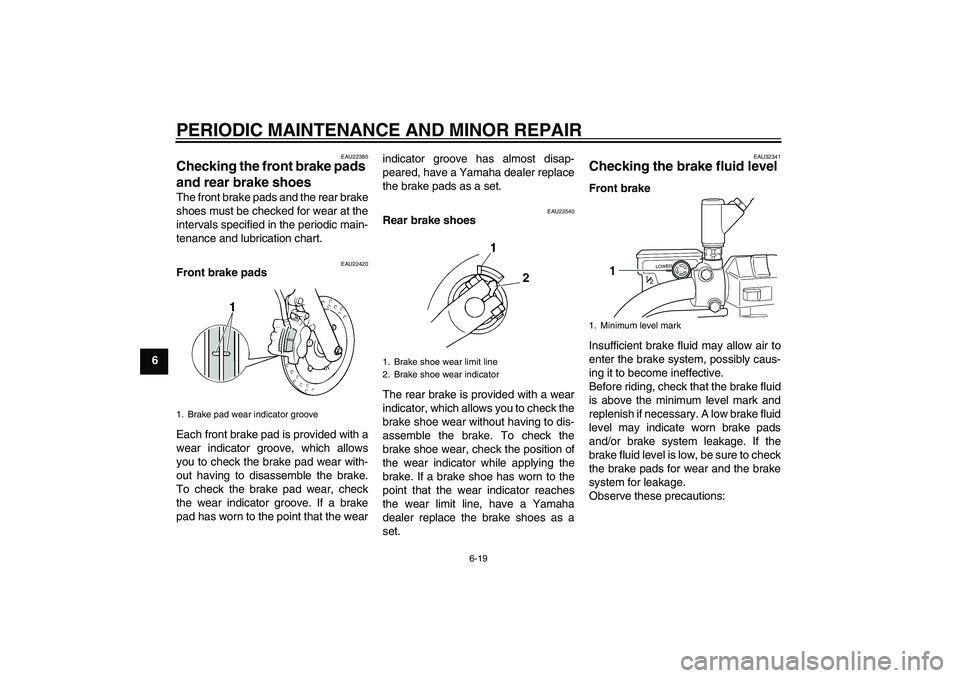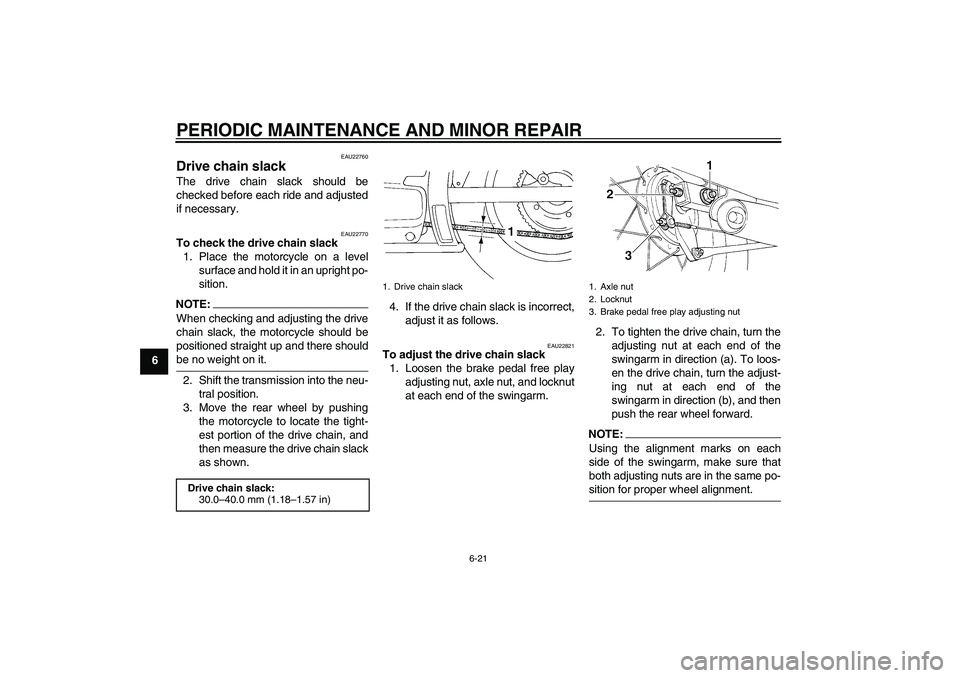Page 49 of 82

PERIODIC MAINTENANCE AND MINOR REPAIR
6-16
6 3. If the specified clutch lever free
play could be obtained as de-
scribed above, tighten the locknut
and skip the rest of the procedure,
otherwise proceed as follows.
4. Fully turn the adjusting bolt at the
clutch lever in direction (a) to loos-
en the clutch cable.
5. Loosen the locknut at the crank-
case.
6. To increase the clutch lever free
play, turn the adjusting nut in direc-
tion (a). To decrease the clutch le-
ver free play, turn the adjusting nut
in direction (b).7. Tighten the locknut at the clutch le-
ver and the crankcase.
EAU22092
Adjusting the brake lever free
play The brake lever free play should mea-
sure 5.0–8.0 mm (0.20–0.31 in) as
shown. Periodically check the brake le-
ver free play and, if necessary, adjust it
as follows.
1. Loosen the locknut at the brake le-
ver.
2. To increase the brake lever free
play, turn the adjusting screw in di-
rection (a). To decrease the brake
lever free play, turn the adjusting
screw in direction (b).
3. Tighten the locknut.
1. Locknut
2. Clutch lever free play adjusting nut
(crankcase)
1. Locknut
2. Brake lever free play adjusting screw
3. Brake lever free play
5KRE2.book Page 16 Monday, June 23, 2003 3:32 PM
Page 50 of 82

PERIODIC MAINTENANCE AND MINOR REPAIR
6-17
6
WARNING
EWA10630
�
After adjusting the brake lever
free play, check the free play
and make sure that the brake is
working properly.
�
A soft or spongy feeling in the
brake lever can indicate the
presence of air in the hydraulic
system. If there is air in the hy-
draulic system, have a Yamaha
dealer bleed the system before
operating the motorcycle. Air in
the hydraulic system will dimin-
ish the braking performance,
which may result in loss of con-trol and an accident.
EAU22201
Adjusting the brake pedal
position and free play
WARNING
EWA10670
It is advisable to have a Yamahadealer make these adjustments.
Brake pedal position
The top of the brake pedal should be
positioned approximately 76.6 mm
(3.02 in) above the top of the footrest as
shown. Periodically check the brake
pedal position and, if necessary, adjust
it as follows.1. Loosen the locknut at the brake
pedal.
2. To raise the brake pedal, turn the
adjusting bolt in direction (a). To
lower the brake pedal, turn the ad-
justing bolt in direction (b).
3. Tighten the locknut.
WARNING
EWA11230
After adjusting the brake pedal posi-
tion, the brake pedal free play mustbe adjusted.
1. Footrest
2. Distance between brake pedal and footrest
3. Brake pedal free play
1. Brake pedal position adjusting bolt
2. Locknut
5KRE2.book Page 17 Monday, June 23, 2003 3:32 PM
Page 51 of 82

PERIODIC MAINTENANCE AND MINOR REPAIR
6-18
6 Brake pedal free play
The brake pedal free play should mea-
sure 20.0–30.0 mm (0.79–1.18 in) at
the brake pedal end. Periodically check
the brake pedal free play and, if neces-
sary, adjust it as follows.
To increase the brake pedal free play,
turn the adjusting nut at the brake rod in
direction (a). To decrease the brake
pedal free play, turn the adjusting nut in
direction (b).
WARNING
EWA10680
�
After adjusting the drive chain
slack or removing and installing
the rear wheel, always check the
brake pedal free play.
�
If proper adjustment cannot be
obtained as described, have a
Yamaha dealer make this ad-
justment.
�
After adjusting the brake pedal
free play, check the operation ofthe brake light.
EAU22270
Adjusting the rear brake light
switch The rear brake light switch, which is ac-
tivated by the brake pedal, is properly
adjusted when the brake light comes
on just before braking takes effect. If
necessary, adjust the brake light switch
as follows.
Turn the adjusting nut while holding the
rear brake light switch in place. To
make the brake light come on earlier,
turn the adjusting nut in direction (a). To
make the brake light come on later, turn
the adjusting nut in direction (b).
1. Brake pedal free play adjusting nut
1. Rear brake light switch
2. Rear brake light switch adjusting nut
5KRE2.book Page 18 Monday, June 23, 2003 3:32 PM
Page 52 of 82

PERIODIC MAINTENANCE AND MINOR REPAIR
6-19
6
EAU22380
Checking the front brake pads
and rear brake shoes The front brake pads and the rear brake
shoes must be checked for wear at the
intervals specified in the periodic main-
tenance and lubrication chart.
EAU22420
Front brake pads
Each front brake pad is provided with a
wear indicator groove, which allows
you to check the brake pad wear with-
out having to disassemble the brake.
To check the brake pad wear, check
the wear indicator groove. If a brake
pad has worn to the point that the wearindicator groove has almost disap-
peared, have a Yamaha dealer replace
the brake pads as a set.
EAU22540
Rear brake shoes
The rear brake is provided with a wear
indicator, which allows you to check the
brake shoe wear without having to dis-
assemble the brake. To check the
brake shoe wear, check the position of
the wear indicator while applying the
brake. If a brake shoe has worn to the
point that the wear indicator reaches
the wear limit line, have a Yamaha
dealer replace the brake shoes as a
set.
EAU32341
Checking the brake fluid level Front brake
Insufficient brake fluid may allow air to
enter the brake system, possibly caus-
ing it to become ineffective.
Before riding, check that the brake fluid
is above the minimum level mark and
replenish if necessary. A low brake fluid
level may indicate worn brake pads
and/or brake system leakage. If the
brake fluid level is low, be sure to check
the brake pads for wear and the brake
system for leakage.
Observe these precautions:
1. Brake pad wear indicator groove
1. Brake shoe wear limit line
2. Brake shoe wear indicator
1. Minimum level mark
5KRE2.book Page 19 Monday, June 23, 2003 3:32 PM
Page 53 of 82

PERIODIC MAINTENANCE AND MINOR REPAIR
6-20
6
�
When checking the fluid level,
make sure that the top of the mas-
ter cylinder is level by turning the
handlebars.
�
Use only the recommended quality
brake fluid, otherwise the rubber
seals may deteriorate, causing
leakage and poor braking perfor-
mance.
�
Refill with the same type of brake
fluid. Mixing fluids may result in a
harmful chemical reaction and
lead to poor braking performance.
�
Be careful that water does not en-
ter the master cylinder when refill-
ing. Water will significantly lower
the boiling point of the fluid and
may result in vapor lock.
�
Brake fluid may deteriorate paint-
ed surfaces or plastic parts. Al-
ways clean up spilled fluid
immediately.
�
As the brake pads wear, it is nor-
mal for the brake fluid level to grad-
ually go down. However, if thebrake fluid level goes down sud-
denly, have a Yamaha dealer
check the cause.
EAU22720
Changing the brake fluid Have a Yamaha dealer change the
brake fluid at the intervals specified in
the NOTE after the periodic mainte-
nance and lubrication chart. In addition,
have the oil seals of the brake master
cylinder and caliper as well as the
brake hose replaced at the intervals
listed below or whenever they are dam-
aged or leaking.�
Oil seals: Replace every two
years.
�
Brake hose: Replace every four
years.
Recommended brake fluid:
DOT 4
5KRE2.book Page 20 Monday, June 23, 2003 3:32 PM
Page 54 of 82

PERIODIC MAINTENANCE AND MINOR REPAIR
6-21
6
EAU22760
Drive chain slack The drive chain slack should be
checked before each ride and adjusted
if necessary.
EAU22770
To check the drive chain slack
1. Place the motorcycle on a level
surface and hold it in an upright po-
sition.NOTE:When checking and adjusting the drive
chain slack, the motorcycle should be
positioned straight up and there shouldbe no weight on it.
2. Shift the transmission into the neu-
tral position.
3. Move the rear wheel by pushing
the motorcycle to locate the tight-
est portion of the drive chain, and
then measure the drive chain slack
as shown.4. If the drive chain slack is incorrect,
adjust it as follows.
EAU22821
To adjust the drive chain slack
1. Loosen the brake pedal free play
adjusting nut, axle nut, and locknut
at each end of the swingarm.2. To tighten the drive chain, turn the
adjusting nut at each end of the
swingarm in direction (a). To loos-
en the drive chain, turn the adjust-
ing nut at each end of the
swingarm in direction (b), and then
push the rear wheel forward.
NOTE:Using the alignment marks on each
side of the swingarm, make sure that
both adjusting nuts are in the same po-sition for proper wheel alignment.
Drive chain slack:
30.0–40.0 mm (1.18–1.57 in)
1. Drive chain slack
1. Axle nut
2. Locknut
3. Brake pedal free play adjusting nut
5KRE2.book Page 21 Monday, June 23, 2003 3:32 PM
Page 55 of 82

PERIODIC MAINTENANCE AND MINOR REPAIR
6-22
6
CAUTION:
ECA10570
Improper drive chain slack will over-
load the engine as well as other vital
parts of the motorcycle and can lead
to chain slippage or breakage. To
prevent this from occurring, keep
the drive chain slack within thespecified limits.
3. Tighten both locknuts and the axle
nut to the specified torques.4. Adjust the brake pedal free play.
(See page 6-17.)
WARNING
EWA10660
After adjusting the brake pedal free
play, check the operation of thebrake light.
EAU23020
Lubricating the drive chain The drive chain must be cleaned and
lubricated at the intervals specified in
the periodic maintenance and lubrica-
tion chart, otherwise it will quickly wear
out, especially when riding in dusty or
wet areas. Service the drive chain as
follows.CAUTION:
ECA10580
The drive chain must be lubricated
after washing the motorcycle orriding in the rain.
1. Clean the drive chain with kero-
sene and a small soft brush.CAUTION:
ECA11120
To prevent damaging the O-rings, do
not clean the drive chain with steam
cleaners, high-pressure washers orinappropriate solvents.
2. Wipe the drive chain dry.
3. Thoroughly lubricate the drive
chain with a special O-ring chain
lubricant.
1. Alignment marks
2. Drive chain slack adjusting nut
3. Locknut
Tightening torques:
Locknut:
16 Nm (1.6 m·kgf, 12 ft·lbf)
Axle nut:
104 Nm (10.4 m·kgf, 75 ft·lbf)
5KRE2.book Page 22 Monday, June 23, 2003 3:32 PM
Page 56 of 82

PERIODIC MAINTENANCE AND MINOR REPAIR
6-23
6
CAUTION:
ECA11110
Do not use engine oil or any other lu-
bricants for the drive chain, as they
may contain substances that coulddamage the O-rings.
EAU23100
Checking and lubricating the
cables The operation of all control cables and
the condition of the cables should be
checked before each ride, and the ca-
bles and cable ends should be lubricat-
ed if necessary. If a cable is damaged
or does not move smoothly, have a
Yamaha dealer check or replace it.
WARNING
EWA10720
Damage to the outer sheath may in-
terfere with proper cable operation
and will cause the inner cable to
rust. Replace a damaged cable as
soon as possible to prevent unsafeconditions.
EAU23110
Checking and lubricating the
throttle grip and cable The operation of the throttle grip should
be checked before each ride. In addi-
tion, the cable should be lubricated or
replaced at the intervals specified in the
periodic maintenance chart.
Recommended lubricant:
Engine oil
5KRE2.book Page 23 Monday, June 23, 2003 3:32 PM